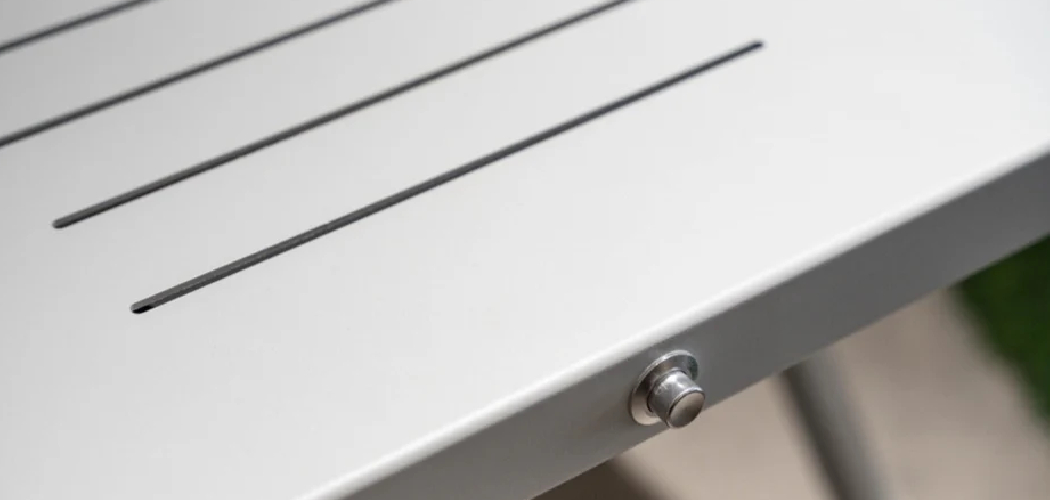Are you looking for ways to clean your metal table? Metal tables are popular due to their durability and sleek appearance, but they can also accumulate dirt and grime over time.
How to clean metal table involves more than just wiping the surface with a damp cloth. To maintain its luster and longevity, it’s essential to use the right techniques and materials. Metal tables, whether stainless steel, aluminum, or iron, can accumulate dust, fingerprints, and even rust over time, requiring regular maintenance. By following simple steps, you can effectively clean your metal table, remove stubborn stains, and ensure it remains pristine.
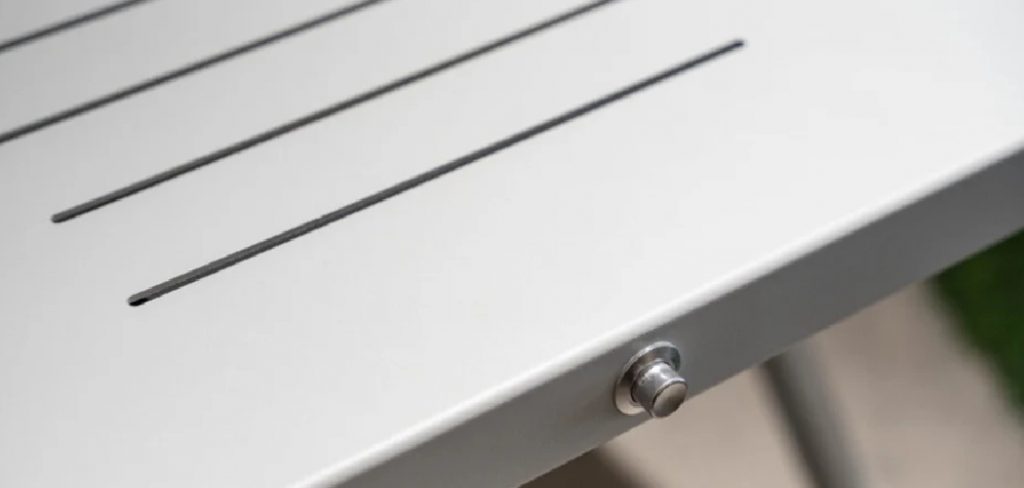
This guide provides the necessary instructions and tips to achieve a spotless and polished metal table, enhancing its appearance and durability.
What Will You Need?
Before cleaning, gather all the necessary materials to make the task more efficient. Here are some items you will need:
- Mild dish soap
- Warm water
- Soft cloth or sponge
- White vinegar
- Baking soda
- Lemon juice
- Olive oil
You can also invest in a specialized metal cleaner if your table is filthy or has tough stains. Once you have all these items, let’s start cleaning your metal table.
10 Easy Steps on How to Clean Metal Table
Step 1: Remove Loose Dirt and Dust
Use a soft cloth or a duster to gently wipe away any loose dirt or dust particles from the surface of your metal table. This initial step is crucial because it prevents scratches if dirt is rubbed into the metal during cleaning. Ensure you cover the entire surface, including corners and edges, where dust accumulates. For hard-to-reach areas or intricate designs, a small soft-bristled brush can effectively dislodge dirt without damaging the metal. Removing all loose particles thoroughly will make the subsequent cleaning steps more effective, allowing for a more thorough and spot-free finish.
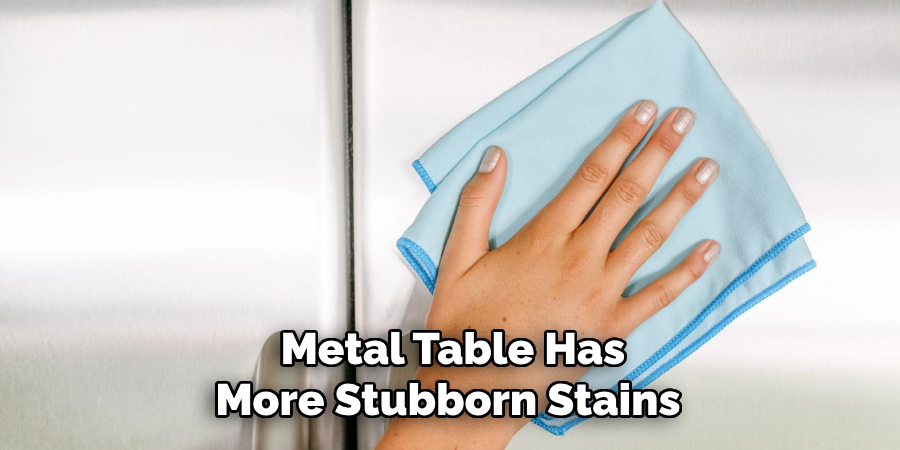
Step 2: Prepare a Cleaning Solution
Mix a few drops of mild dish soap with warm water in a bowl or bucket. Ensure the solution is well-blended but not overly soapy, as excessive suds can leave residue on the metal surface. This gentle solution will help break down oils and dirt without causing damage. If your metal table has more stubborn stains or is particularly filthy, consider adding a small amount of white vinegar to the solution, enhancing the cleaning power.
Step 3: Wipe Down the Surface
Dip a soft cloth or sponge into the cleaning solution, ensuring it is damp but not soaking wet. Carefully wipe down the entire surface of the metal table, working in sections if needed. Apply gentle pressure to lift any dirt and grime without scratching the metal. For more challenging spots, let the solution sit for a minute before wiping it away. Be sure to follow the grain of the metal, if there is one, to maintain its natural appearance. Regularly rinse the cloth or sponge in clean water to avoid spreading dirt around, and continue until the entire table has been cleaned.
Step 4: Tackle Stubborn Stains
For more persistent stains or rust spots on your metal table, you may need to employ more robust cleaning techniques. Start by creating a paste using baking soda and a small amount of water. The paste should have a thick, spreadable consistency. Apply this paste directly onto the stained area, allowing it to sit for approximately 15 minutes. This will give the baking soda time to help break down the stain without damaging the metal.
For enhanced effectiveness against rust, consider adding some lemon juice to the paste, as the acid can aid in lifting the rust. Gently scrub the area using a soft sponge or cloth, applying in a circular motion to work the paste into the stain. Avoid using abrasive materials that can scratch the metal surface. Once the stain has been sufficiently treated, rinse the table with clean water to remove any remaining paste residue.
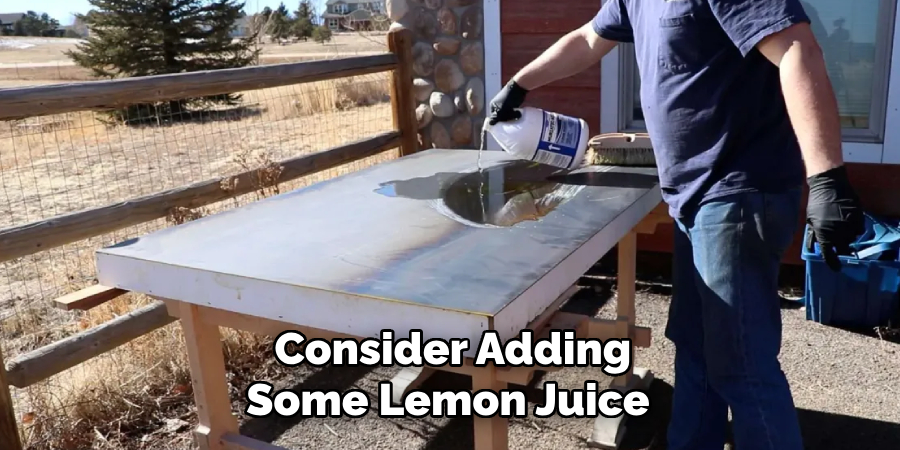
Step 5: Rinse the Table
After addressing any stains, it’s essential to rinse your metal table thoroughly. Use a clean, damp cloth to wipe down the entire surface, removing all soap, vinegar, and paste residues. Rinsing is crucial because leftover cleaning agents can leave streaks or cause build-up over time. Pay attention to any grooves or detailed areas where residue might accumulate. By ensuring a proper rinse, you maintain the table’s shine and safeguard against potential chemical interactions that could dull the metal surface.
Step 6: Dry the Table Completely
Once you’ve rinsed the table, it’s essential to dry it thoroughly to prevent water spots and streaks. Use a soft, clean towel or microfiber cloth to pat the surface dry gently. Pay special attention to edges and corners where water might collect. Moisture left on the metal surface can also lead to rusting, particularly in iron or steel tables, so ensuring the table is fully dry is key to preserving its finish. If possible, allow the table to air dry in a well-ventilated area to ensure any remaining moisture evaporates completely.
Step 7: Polish the Metal Surface
Polishing your metal table will enhance its shine and protect it from future tarnish or damage. To polish, apply a small amount of olive oil or a specialized metal polish onto a soft cloth. Rub the oil or polish into the metal using circular motions, covering the entire surface evenly. This will help to improve the table’s luster and create a protective barrier against fingerprints and minor scratches. Be sure to buff away any excess oil or polish thoroughly to avoid a greasy residue that may attract dust or dirt. Regular polishing will maintain the table’s attractive appearance and extend its overall lifespan.
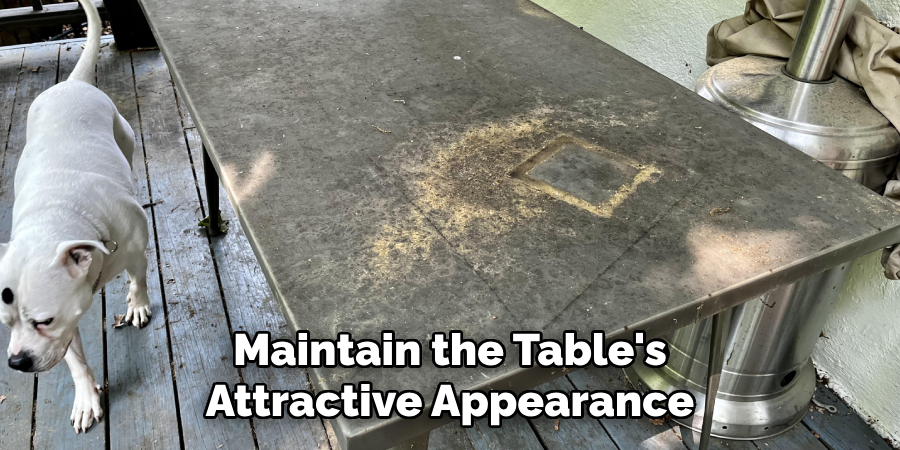
Step 8: Inspect for Missed Spots
Take a moment to carefully inspect the entire surface of your metal table for any missed spots or areas that may require additional attention. Check for remaining stains, water spots, or any areas that still appear dull compared to the rest of the table. Repeat the cleaning or polishing steps on these specific areas to ensure a consistent, streak-free finish. Attention to detail in this final inspection will ensure that all areas are noticed, resulting in a spotless and well-maintained table.
Step 9: Apply a Protective Coating
Consider applying a protective coating to further safeguard your metal table from future damage. Use a high-quality metal sealant or wax, which can act as a barrier against moisture, dust, and minor scratches. Apply the sealant according to the manufacturer’s instructions, usually by squirting a small amount onto a soft cloth and buffing it into the metal surface in even, circular motions. Ensure the entire surface, including any grooves or decorative areas, is evenly covered. This protective layer will help preserve the appearance and integrity of the table over time, reducing the frequency of required cleanings and extending its lifespan.
Step 10: Store the Table Properly
Proper storage is essential to maintain its condition if your metal table is used outdoors or during specific seasons only. Before storing, ensure the table is immaculate and dry. If possible, dismantle or fold the table for more compact storage. Use a cover or protective wrap to shield the table from dust, moisture, and direct sunlight. Store it in a cool, dry place to prevent rust and corrosion. Proper storage will ensure that your metal table remains in excellent shape, ready to be used again.

By following these steps, you can effectively clean and maintain your metal table to keep it looking new for years.
5 Things You Should Avoid
1. Using Abrasive Cleaners: Abrasive cleaners can scratch the surface of the metal, leaving it dull and damaged. To preserve the table’s original finish, it’s essential to use soft cloths and gentle cleaning solutions.
2. Ignoring Rust Spots: Promptly addressing rust spots can lead to more extensive damage. It’s essential to treat rust immediately with appropriate rust-removal products to prevent it from spreading.
3. Applying Bleach: Bleach can corrode metal surfaces and cause discoloration. It’s best to avoid using bleach or any other harsh chemicals on metal tables.
4. Using Steel Wool or Wire Brushes: While these may seem like practical tools for removing tough stains, they can cause scratches and damage to the table’s surface. Opt for gentler cleaning methods instead.
5. Skipping Regular Cleaning: Neglecting regular cleaning can lead to a buildup of dirt, grime, and other substances that can be difficult to remove later on. Make sure to clean your metal table regularly to prevent this from happening.
Conclusion
In conclusion, maintaining the pristine condition of your metal table requires careful attention and appropriate cleaning methods.
Avoid abrasive materials and harsh chemicals that can damage the surface. Instead, rely on soft cloths and gentle cleaning agents designed for metal. Address any rust spots quickly with suitable removal products to prevent them from worsening. Regular cleaning keeps your table fresh and prevents stubborn dirt or grime buildup.
By following these guidelines on how to clean metal table, you can ensure your metal table remains an elegant centerpiece in your space for years to come.
